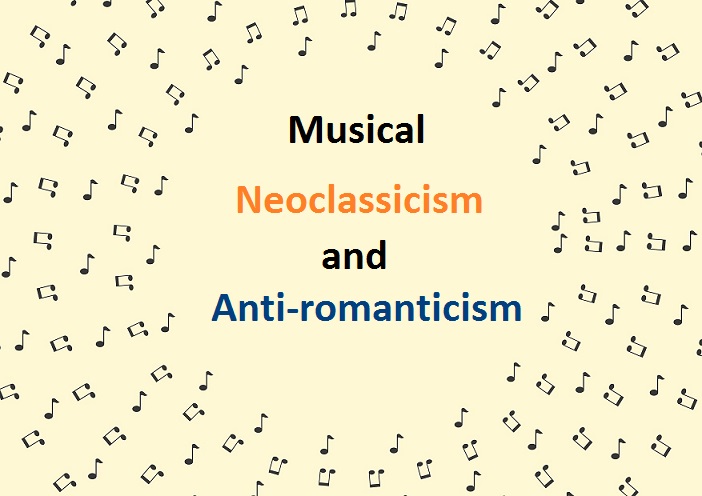
The years between the World Wars saw a speeding up of musical history. Prior to this period, broad encompassing terms for periods of musical development, such as ‘classical’, ‘renaissance’, or ‘baroque’, usually spoke of periods of time lasting several centuries, or at least several generations. By the early twentieth century, the late romantic period had already mostly given way to a number of new musical directions – Debussy and Ravel experimented with ideas of Impressionism in music, and composers such as Schoenberg, Webern, and Berg were creating works based off serialist, 12-tone row procedures(to name only two).
By the end of the Second World War, these movements and others had already given way to other directions – Bartok and Khachaturian pursued folk influences, numerous composers in America were influenced by jazz and works for stage and film, John Cage was looking into the music of chance and random sounds. Within this historically volatile climate of the early twentieth century, I would like to examine two similar musical genres which were explored by a number of extremely influential composers: neoclassicism and anti-romanticism.
Musical Anti-Romanticism
Anti-romanticism, as the name suggests, was a reaction against the ideas of musical romanticism. This is realized in a number of different ways. Early anti-romanticism, such as that evidenced in the works of Debussy, showed a change in the focus of depictive music from the grand and all-encompassing(for instance, the symphonies of Mahler, which are akin to self-contained universes of expression) to the subtle and personal. An instance of this can be shown in Debussy’s piano etudes, which show a preponderance with rippling water-like effects and delicate twinkling sonorities. Similarly, many of the piano works by Eric Satie show a focus on non-directional harmonies – this means chords are used not for their tonal function but simply for their unique color and expressive qualities.
The music is kept relatively simple and elegant to allow focus on these delicate and extremely personal sound worlds. The reduction from grandeur and dramaticism is not just a reduction from orchestral to piano textures – piano works by Liszt or Mussorgsky, with their massive explosive gestures show how the excesses of romanticism could be displayed in full swing on a keyboard. However, reduced scoring, whether due to limited funding during the war or due to the composer’s personal choice, is an oft-cited anti-romantic feature.
Works such as Stravinsky’s ‘A Soldier’s Tale’, which uses a large chamber ensemble set up(7 musicians actors), or Olivier Messiaen’s ‘Quartet for the End of Time’, which used the meager available musicians of a concentration camp despite its extremely heavy and serious subject matter, demonstrate this. As one of the main ideas of musical romanticism was dramatic self-expression, many works that demonstrate a return to structured formality exemplify both anti-romanticism and neoclassicism.
Neoclassicism Music
Whereas anti-romanticism was showing itself in a number of forms by the very late nineteenth century, it wasn’t until around the 1920s that neoclassicism started to develop a distinct following. Neoclassicism is often used to describe works that make use of classical or baroque musical references or compositional techniques juxtaposed with the increased rhythmic, harmonic, and melodic vocabulary of the twentieth century.
One simple example of this might be writing an Alberti bass figure(the type of classical harmonic compositional feature) which makes use of extended chords such as 9ths or 11ths. Some examples of composers who used neoclassical compositional techniques include Bartok(the first movement of his ‘Music for Strings, Percussion, and Celesta’ uses a traditional baroque form fugue structure but with winding chromatic melodies and constantly changing time signatures), Hindemith(his series of ‘Kammermusic’ works include numerous references to Baroque forms such as the concerto grosso, and melodic figuration and ornamentation reminiscent of baroque dances) and most famously Stravinsky(whose notable ‘Octet’ for winds includes stripped down and exposed harmonic and rhythmic features, blatantly referencing classical mores).
This style, which developed almost internationally, was a reaction to the extreme complexity of the Second Viennese School and other complex process derived composers such as Edgard Varese. Often, but not always, this music is typified by construction that serves only to fulfill a musical form – in a similar manner perhaps as solving a musical puzzle.
Stravinsky’s reasoning behind writing neoclassical works mostly for winds was that he felt that their tone was much harder and more exact, and less expressive and vague than that of string sections. A term strongly associated with this style is ‘Gebrauchsmusik’, translated to ‘utility music’, meaning music composed for a specific purpose such as an event or commission, as opposed to a personal desire for self-expression.
From this, it can be seen that while there is some common ground between neoclassicism and anti-romanticism, they are still separate musical movements, and certainly not interchangeable. I hope this has helped to increase your understanding of these oft-confused terms.
